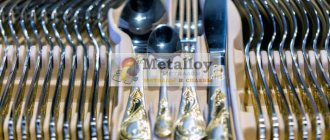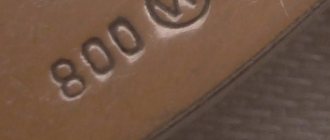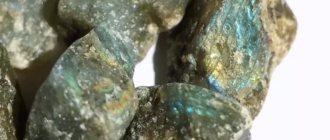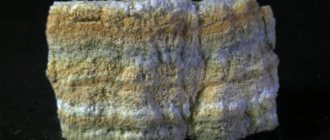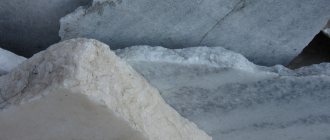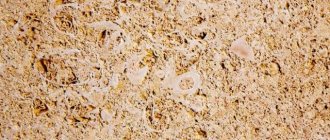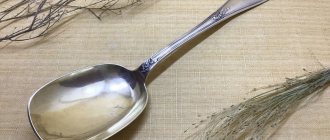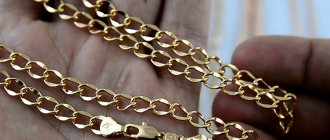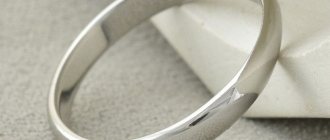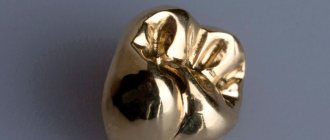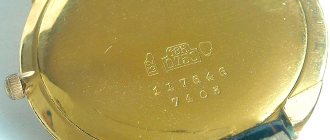What is nickel silver? Judging by its composition and properties, we can say that it is an improved version of an older alloy - cupronickel, invented back in 1819. Unlike cupronickel, which consists only of copper and nickel, nickel silver also necessarily contains zinc, and in addition to it, iron and some other alloying elements.
Properties of nickel silver tape
Depending on the heat treatment method (or lack thereof), the nickel silver ribbon is shipped in the following condition:
- soft - with strength over 340 MPa and ductility, indicating relative elongation, above 27%;
- semi-solid – with a strength of 440-450 MPa and a plasticity of 2-4%;
- hard – 540-690 MPa, without regulation of plasticity;
- especially hard - with a strength above 690 MPa.
The properties of the MNTs15-20 tape are influenced by the structure of the alloy, which is based on nickel with cobalt - (13.5-16.5%), zinc - (18-20%), the rest is occupied by copper. Due to the presence of zinc, nickel silver tape differs from nickel silver in that the product costs less; otherwise, the structure and properties of the products are quite similar. The content of impurities in the nickel silver alloy slightly changes the quality of the product and their introduction into the alloy is limited.
The advantages of nickel silver include the following:
- beautiful external appearance, due to which the metal is popular in the decorative field;
- Excellent mechanical characteristics, which ensure ease of processing in cold and heated states, and cutting. Among other things, soldering is possible;
- resistance to corrosion due to the presence of nickel in the alloy;
- comfortable ratio of quality and price.
The manufactured products are distinguished by their attractive appearance, durability and reliability. Nickel silver is similar in appearance to silver, without losing its shine over time. The alloy does not harm humans and does not darken, therefore it is popular among jewelers who make precious items. You can purchase MNTs15-20 tape with standard accuracy, as well as with improved processing with increased accuracy.
The quality of the workpieces is subject to strict checks at all production stages, due to which the surface condition of the products is in accordance with the requirements of state standards (without scratches, tears, delaminations and other mechanical defects or damage).
Technical conditions are regulated by GOST 5187-2003. The alloy structure complies with GOST 492-2006. The accuracy of tape processing is regulated by GOST 26877-2008. The composition of nickel included in the alloy structure must comply with GOST 849-2008.
Marking of silver and silver-plated products
Some time ago I was faced with the need to understand the markings of Italian silver. And when I shared this information with my friend, who has long had a vintage store here at the Crafts Fair, she was surprised to learn that she also did not know all the intricacies of marking silver items. That’s why I decided – I need to write about it!
So, I am sharing useful information about marking silver products. Silver items in Italy are marked with the numbers 800, less often 925 (as a rule, 925 silver is used in jewelry). These numbers mean that every 1000 units of material consist of 800 (or 925) parts of silver and 200 (or 75) parts of copper. Pure silver is not used in the production of interior items, tableware and jewelry, as it is too soft. I will write about the evolution of the hallmark of Italian silver products a little lower.
Foreign, non-Italian silver items may have different markings. Thus, American silver is often marked Sterling, which is analogous to the 925 marking. English craftsmen use the “walking lion” symbol, which guarantees the 925 marking, and, in addition to this symbol, they put a mark with the date and city of manufacture, and older products have information about head of state. The rest of the European countries, except England, use the same labeling as Italy.
Not only silver items are marked. So, for example, I came across the mark of Alpacca, an alloy in composition very similar to cupronickel and nickel silver. None of these alloys, cupronickel, nickel silver and alpaca, contain silver, but alpaca makes a very good base for silver plating, and nickel silver cutlery is almost always plated with a thin layer of silver to remove the metallic taste. Some English and American items are marked German Silver, which means nickel silver. The Sheffield mark is also not silver, but old Sheffield pieces are always very high quality and therefore have a high value.
I would like to draw your attention to the Arg.800 and Arg.1000 markings used by Italian craftsmen. This marking means that the product is not silver, but silver-plated, that is, a thin silver layer is applied to the surface of the alloy, most often by galvanic method
Well, a little more about the evolution of the silver hallmark in Italy. Italian craftsmen were required to use a single mark by law of May 2, 1872. A woman's head was used as a brand. The head with the number 1 was an analogue of 950, with the number 2 - 900, and without the number - 800.
From 1890 to 1934, markings were only numbers, without an oval, often in parallel with the symbols previously used by the jeweler, such as a flower.
With the advent of fascism in 1934, another mark was added to identify jewelers. The 800 marking was now located inside an oval, and they also began to use a hexagon containing the manufacturer's identification number, the littorio (symbol of fascism) and the initials - the abbreviation of the province in which the object was made.
With the end of the Fascist period in 1944 and until 1968, the same marking 800 inside the oval and the hexagon containing the manufacturer's identification code with the initials of the province in which the object was made continued to be used, but the littorio ray disappeared in the hexagon.
Since 1968, the 800 or 925 marking has always been enclosed in an oval, but the shape of the hexagon has changed - a star appeared inside, then the manufacturer's number and, finally, an abbreviation of the initial letters of the province where the product was made. This marking is still in use today.
PS All labeling data was taken from Italian websites, as well as after consultation with specialists in vintage products and antiques. Unfortunately, I couldn’t attach photos: those available on the Internet are too small in size.
Technological characteristics
During the melting process, the red tint of the copper is absorbed by the nickel. The result is an alloy of white, white with a blue or greenish tint with a deep glossy texture.
When lead is added to the alloy, the glossy shine fades and a gray tone clearly appears. The specific gravity of the copper-nickel alloy is 7.5 grams per cubic meter. cm.
For further processing, ingots, rods, strips, pipes and wires are produced. The main processing method is cutting and pressure forming. Nickel silver can be heated and cooled, forged, and minted.
When using nickel silver as tableware, the metal is plated with silver or gold. For instruments and electrical products, the metal is polished to a mirror finish.
When covering cutlery, the layer of silver or gold plating is regulated by state standards - for forks and spoons it must be at least 24.00 microns, for knife handles 18.0 microns.
Advantages and disadvantages
Cupronickel tableware has many advantages over products made from other materials. The main ones:
slow heating, which is extremely important for appliances used in the kitchen; cupronickel products have a beautiful appearance; the material does not suffer from corrosion; metal does not bend, because has high strength; Cupronickel has a positive effect on the human body, because
contains nickel and copper ions; the metal has a more affordable price than silver.
In addition, this material has a significant service life and has a positive effect on the human body. It is as follows:
Nickel ions, concentrating in the human body, stabilize the glucose balance, which is extremely important for patients with diabetes; these compounds stabilize blood pressure in hypertension; copper is required by the body for the stable course of protein metabolism processes and maintaining the functioning of the musculoskeletal system; this microelement has a slight antibacterial effect.
Medical experts note that regular use of spoons, forks and knives made of nickel and copper alloy can improve overall well-being, eliminate increased nervousness and aggression, and also minimize the manifestation of seasonal vitamin deficiencies.
Disadvantages of the material:
- Cutlery, dishes and jewelry made of copper-nickel alloy quickly lose their original attractiveness. Dark marks and deposits on the surface are a natural process that is activated due to the oxidation of the material. This metal deficiency is considered the main one.
- Things made from this alloy require regular and proper care. Due to the fact that devices made from this material darken, they must be cleaned regularly to restore their beauty.
- Nowadays it is difficult to find things made from high-quality cupronickel, because... they are produced in small batches.
- Some believe that devices made from this metal have already gone out of fashion. However, this “minus” can at the same time be considered an advantage if we consider a spoon or fork from the times of the USSR as an antique.
Nickel silver and cupronickel
Nickel silver, sadly enough, suffered the fate of being in the shadow of cupronickel. Cupronickel is a more expensive alloy with a more beautiful and sonorous name. Therefore, very often the products were called cupronickel, but they were made from nickel silver. Over time, more and more, as a result, today cupronickel is almost completely replaced by nickel silver, and cutlery and dishes are still called cupronickel. “Cupronickel silver” has become a household name along with copying machines, which everyone calls copiers, SUVs, which everyone calls jeeps, and other diapers, which everyone calls pampers, etc. So they are made from nickel silver and they bear the mark MNTs15-20.
By and large, nickel silver differs from cupronickel only in the presence of zinc in the composition, despite the fact that their properties and appearance are identical and the differences can vary only for different brands of nickel silver and cupronickel. Thus, we have already described all the differences between nickel silver and silver in the article about cupronickel and we will not repeat ourselves; we will only note once again the fact that almost all cupronickel cutlery and dishes today are made from nickel silver.
Markings used
For all products made from cupronickel, the sample is designated by two capital letters: M and N. They mean that the alloy contains copper and zinc. If next to the letters MN are also indicated Zh, as well as MC, then manganese and iron were used in the form of a ligature. In addition to the standard letter designation, numbers are also used in production. For example, if the product is marked MNZHMts 30−1−1, then the alloy, in addition to the standard copper base, contains 30% nickel, 1% iron and 1% manganese.
On the territory of Russia, cupronickel devices and jewelry were especially actively produced before the collapse of the USSR. After this, the alloy began to be produced at a serial level with the addition of zinc. Thanks to this, nickel silver (one of the varieties of cupronickel) was obtained. Today, products made from a copper-nickel alloy without the addition of zinc can only be bought in an antique shop. In appearance and strength, nickel silver devices cannot be distinguished from real silver, but only expensive metal can darken as a result of contact with a damp surface.
A distinctive feature of the copper-nickel alloy is its mark - MNC. But in some cases there may be no sample on the product. To correctly determine the marking, you need to find out the date of manufacture or evaluate the color of the device or decoration. If there is a yellow tint in the alloy, then we are talking about nickel silver.
Basic requirements
We have already answered the question of what school chalk is made from. Its composition is quite diverse. The basic requirements for writing material are:
- should not crumble when writing on the board;
- should not get your hands too dirty;
- the white product must be pure;
- absence of hard inclusions that scratch the board.
Chalk from Pegas LLC (Klin) almost does not crumble, as it is quite dense. But the products produced by LLC “get your hands very dirty. These samples use gypsum as a thickener rather than starch.
By the way, chalk cannot corrode the skin of your hands, since the reaction of its environment is neutral. Continuous work with this mineral can cause dry skin on your hands. Therefore, wash them more often and lubricate them with protective cream.
Brooches and bracelets
Multifunctional brooches are used as an independent decoration or as a decorative clasp for a voluminous stole, a stylish cardigan, or a coat. Women 40+ accessorize bags, gloves, and hats.
Mineral inserts are best combined with a silver alloy:
- nephritis;
- malachite;
- charoite;
- agate;
- cornelian;
- amber.
These stones serve as decoration for the alloy and increase the decorative value of jewelry. Exclusive bracelets with large, voluminous single stones of an original shape and with flat multi-colored mosaics are popular among lovers of gems.
History of origin
As usually happens in life, the reason for the birth of a new alloy was an acute shortage of more valuable and expensive metal. This was the case with the ancestor of nickel silver - cupronickel. The lack of silver for minting the most popular coins forced the rulers of China to order several government agencies to find a cheap replacement. History says that in the 8th century. BC e. the solution was found in a very original way - alchemists and counterfeiters proposed a recipe for a new alloy, which did not contain a single gram of silver, but the coins were of such high quality that even the craftsmen could not distinguish cupronickel coinage from real silver ones
As a result, the former received a huge reward in the form of saved silver, the latter received life, which is also important, but humanity gained a new alloy of copper, nickel and zinc with excellent chemical and physical properties
But, as befits a secret, the secret of cupronickel’s components was carefully protected by the state, so alchemists in many countries continued to work on finding a recipe for “new silver.”
History, with a slight amendment, repeated itself in the 19th century in Germany. Germany, famous for its metallurgists and chemists, experienced an acute shortage of silver. It got to the point that silver coins began to be valued several times higher than their face value. And only the emergence of a new alloy - nickel silver - made it possible to solve this problem.
Nickel silver wire
The resulting alloy was not only cheaper than cupronickel, but also had higher chemical qualities - it did not corrode, was mechanically strong, malleable, and most importantly, it was susceptible to destruction in a boiling solution of sulfuric and hydrochloric acids.
The industrial production of nickel silver occurred at the beginning of the 19th century, then during the time of Napoleon, a similar composition was obtained by French chemists. And as often happens in history, each of the inventors gave his brainchild his own name. The French - Myshore, the Germans - German silver. But fate turned out to be favorable to the Germans; they did not limit the use of metal only to the issue of coins - they went further, cutlery, gift plates and glasses, inexpensive jewelry and watches appeared from it, as from cupronickel. So it was the name nickel silver that finally stuck, displacing its French counterpart.
Since 1825, the name was finally assigned to the alloy for cutlery and jewelry.
But in Russia it did not take root. The name cupronickel was actively used here. At the same time, the metal was mainly used by wide sections of the population; the intelligentsia, townspeople and wealthy peasantry could afford dishes and jewelry made from “Polish silver” and “German alloy”. Namely, the term “nickel silver” is firmly entrenched in the vocabulary of professionals - metallurgists, chemists, jewelers and merchants.
Historical excursion
The emergence of nickel silver is associated with cupronickel, invented in China. In the 8th century BC e. In China, there was an acute shortage of gold and silver to mint coins from. Then the Chinese ruler ordered alchemists to invent a material that would be less expensive. This is how inexpensive cupronickel appeared. It was durable and could replace coins and jewelry. Chinese scientists kept the composition and formula of cupronickel a secret for a long time, because it was very similar to the precious metal and was much cheaper.
Over time, cupronickel became famous in Europe. The society was interested in the composition of the alloy. European scientists have been trying to solve this mystery for a long time. They discovered the composition of cupronickel (copper, nickel and zinc), but they could not reveal the amount of each metal. Then all experiments were stopped for 300 years. Only in the 19th century in Germany were they able to obtain an analogue of cupronickel. However, in reality the resulting metal was different. It turned out to be the most durable and stable, and the destruction of its composition occurred only in boiling sulfuric and hydrochloric acids. Thus, German chemists invented a new alloy - nickel silver. Its cost is much lower than that of cupronickel and silver.
In Germany in 1825, a factory was created that produced cupronickel spoons, forks, and plates on a large scale. Watches, jewelry, etc. were also made from it.
In the 19th century in Europe, cupronickel was widely used. In Russia, it was used only by the poor population, and it was called as Polish silver, German composition, silveroid. However, by the end of the 20th century, the name cupronickel replaced all other names. The word "nickel silver" is a technical term used in metallurgy.
Application of material
Polymer additives added to concrete using technology give the material special reliability and strength, so the scope of polymer concrete in construction is extensive. The mixture is used to decorate paths, terraces, borders, stairs, fences, swimming pools, and building plinths. In addition, mortars and polymer fillers are suitable for interior and exterior finishing of wall surfaces, and polymer concrete is also used to make a strong and durable self-leveling floor. The material is flexible and ductile, so it can be used to make various decorative shapes and elements. After drying, the finished product can be painted using acrylic paints.
Mechanical properties of the alloy
Mechanical properties include indicators such as hardness, strength, elastic limits, fluidity, strength under elastic influences, metal fatigue and some other characteristics. The addition of nickel increases the hardness and strength of the alloy, and also improves its elastic properties. Nickel silver is used to make materials of different properties - soft, hard, very hard products with correspondingly different mechanical characteristics.
Brinnell metal hardness testers (durometers) are devices for non-destructive measurement of the hardness of metals and alloys on the scale of the same name. They are characterized by high accuracy, thanks to which they have acquired the status of reference.
Nickel silver casting
Casting nickel silver is a complex business. The casting temperature for nickel silver is 1120 °C. According to statistics, when you independently form nickel silver using information from the Internet, 90% of defects are obtained. The efficiency of casting in open systems under pressure is within normal limits if the defect rate is not more than 50%. To get a 100% result, you need to use a specific alloy and a certain type of injection molding machine.
At the moment, the alloy in question is mass produced
When casting nickel silver, the greatest attention is paid to the casting machine and production technology
How to determine the authenticity of cupronickel at home?
It is very difficult for an inexperienced person to distinguish the alloy. There are tests that can determine the alloy:
- Silver-plated or gold-plated devices are marked - MN, MNTs (copper, nickel, zinc). Precious metal items only have a digital hallmark.
- Drop clean water onto the item being tested. After 2-3 hours, the silver will remain unchanged, and a green coating will form on the cupronickel.
- Silver is heavier than cupronickel, so items of equal size will have different weights.
- Having rubbed cupronickel, you can smell copper, silver does not smell of anything.
- If there is no mark on the product, most likely it is cupronickel, even coated with valuable metal.
Storage and care
Caring for cupronickel spoons is quite difficult, especially since cupronickel often darkens. To prevent this from happening, you need to properly care for your cutlery. If they turn black, you should not despair; you can restore them to their original state yourself.
There are many reasons for darkening; the type of product and how it is stored are important. Main reasons:
- high humidity is a real problem for cupronickel spoons, so they are stored in dry places and wiped thoroughly after washing;
- improper care, as food and substances can get into tiny cracks that change the appearance of the device over time.
Various means and methods are used to clean darkened cupronickel spoons. They are perfect for both regular cleansing and old stains.
- Foil. Most often used together with salt and soda. Foil is placed at the bottom of the container, on which the products that need cleaning are placed. They are poured with soda-salt solution and put on fire for about 15-20 minutes. Then turn off the fire and leave the products in water until they cool completely, then rinse thoroughly and wipe dry with a soft cloth.
- Special means. They can be purchased in the hardware departments of supermarkets, they are easy to use, and come in different forms: gel, powder, solution. It is most convenient to use liquid-type products and special wipes. Abrasive substances are excellent for cleaning, but they can damage a set of tablespoons. It is recommended to purchase products that envelop the device after use, protecting it from moisture.
- Soda and vinegar. This is one of the most budget-friendly methods, especially since both products are available in almost every kitchen. About 50 g of soda dissolves in a liter of water, if you use vinegar - 1 teaspoon per 200 ml. Then the products are rubbed with this mixture with a napkin, rinsed, and wiped dry.
- Decoctions. The most popular decoctions for cleaning cupronickel are potato, garlic, and shell decoctions. The shells of two eggs are placed in water (1 liter) and brought to a boil, the darkened product is lowered into it. After a few minutes, take it out and wash it, wipe it. Potato broth is considered a little less aggressive; it is better suited for periodic cleaning.
- Ammonia. 4 tablespoons of alcohol are added per liter of water, and this composition can be used to wash products even with very serious stains.
Often after procedures, cupronickel spoons become dull; to restore the lost shine, various methods are used:
- toothpaste or powder - products are simply rubbed with a product applied to a cotton pad;
- potatoes - you will need half a raw root vegetable, which is used to wipe cutlery;
- pasta - place the utensils into a pan with boiled pasta for 20 minutes, leave the water in the pan, then wash and dry it, and throw away the pasta.
To ensure that cupronickel spoons retain their original appearance for a long time and do not require frequent cleaning, the following rules must be observed:
- do not store devices in places with high humidity in a closed box; it is better to wrap each of them with food-grade film;
- do not use aggressive care products with chlorine, for example, “Belizna”;
- Wash nickel silver utensils only by hand; they cannot be washed in the dishwasher.
To see how easy it is to clean cupronickel in two minutes, watch the following video.
How to care?
In order for products made from an alloy of nickel and copper to look decent and attract attention with their beauty, they must be periodically updated by cleaning and polishing. For this purpose, you can use tooth powder, chalk composition or products intended for the care of jewelry made of precious metals and alloys.
It is important that such cleaning products do not contain acid components or chlorine elements, since these substances form a difficult-to-remove coating on the surface of cupronickel products. Here are a few recipes that you can use to clean cutlery or decorations:
Here are some recipes that you can use to clean your cutlery or decorations.
- The surface is treated with soda dissolved in water in a ratio of 50 g of soda per 1 liter of liquid. It is not recommended to clean nickel silver with dry soda powder, as after such a procedure scratches may appear on the surface of the product. After treating with a soda solution, the product must be rinsed with water and dried with a towel, since wet drops will form stains.
- Another recipe with soda: put a layer of foil in an aluminum container and fill it with a soda solution (the same proportions as in the previous version). Next, you need to put the items that you plan to clean into the container. The container is placed on the stove, and its contents are brought to a boil. Then each item is rinsed in water and wiped dry with a cloth.
- Recipe with ammonia: a little ammonia is diluted in warm water and cupronickel products are placed in the resulting solution. After some time, the objects are removed from the solution, washed in clean water and dried, polishing them with a cloth until they shine.
- Cleaning with eggshells: eggshells must be thoroughly crushed to a powdery state - just take the shells of 2 eggs. Place the eggshell powder in a large container, add a liter of water and add 20 g of salt. Place the container with the solution on the fire and bring to a boil. Then cupronickel items intended for cleaning are placed in a boiling solution and boiled for at least 2-3 minutes. After this, the objects are removed from the solution, washed with water, dried and polished with a clean cloth.
After the cleaning and polishing procedure is completed, products made from cupronickel alloy must be stored in a special box or case with a soft interior. The inside of the storage case must be dry and clean. Typically, cupronickel items are sold already packaged in special boxes or cases, so it is best to store items in them.
It is very important to avoid exposure to moisture, chemicals or perfumes. Also, products should be protected from rough mechanical influences.
By following these simple rules and regularly performing cleaning and polishing procedures, you will be able to admire your nickel silver jewelry or cutlery for many years.
To learn how to clean cupronickel in two minutes, watch the following video.
Pricing
The cost of cupronickel alloys is determined based on the quotations of copper and nickel on world non-ferrous metals exchanges. Basically, scrap metal collection points are oriented towards the London Stock Exchange.
The most valuable are cupronickel, which has a higher nickel content in its composition. This is due to its high cost.
Particular attention should be paid to the condition of the surface when handing over nickel silver scrap. Traces of rust removal, and even more so its presence, greatly reduces the cost of scrap on the non-ferrous metals market
The form of rental is also important. The cupronickel circle is considered the most valuable, t
because with the same weight, a nickel silver pipe takes up more space during transportation. Accordingly, the costs of collection points for moving scrap metal increase.
The volume of supplies also affects the cost indicator. As a rule, metal collectors make a markup when working with cupronickel scrap over 50 kilograms. This happens due to the reduction in time for selling products: the more scrap, the faster it can be sent for processing.
Cupronickel costs less than pure metals. The reason for this is the high cost of processing: separating the original components from each other. As of October 2022, the average price for cupronickel per gram in Russia is 0.2 rubles.
Composition and main characteristics
Cupronickel is an alloy whose composition is 70–80% copper and 30–20% nickel. Contains no more than 1% iron and manganese, 5% cobalt.
It is much stronger than silver and lighter in weight. No magnetic properties. The higher the percentage of manganese and iron in the composition, the greater the ductility, density and thermal conductivity it has. Reacts with other metals, quickly oxidizes under the influence of water and air, so cannot be used in the dishwasher.
There are several types of compositions, which are called cupronickel. The name and technical characteristics depend on the percentage of nickel in the finished material and the presence of other components:
- Nickel silver is an alloy consisting of about 40% copper, up to 15 nickel and up to 45 zinc. Often other metals are added to its basic composition, sometimes it has a bluish or bluish tint. The composition is very durable, strong, elastic.
- Monel is an alloy with a predominance of nickel, it contains up to 67%, copper up to 35%, iron and manganese no more than 2.5%.
- Brass is a material containing up to 80% copper, up to 50% zinc, with nickel, iron, and tin. Previously, this composition belonged to the cupronickel group, so objects made of silver-plated brass were also called cupronickel.
What is nickel silver?
Nickel silver is an alloy of three metals: copper, nickel and zinc. The chemical composition of nickel silver is similar to cupronickel, with one exception: cupronickel does not contain zinc impurities.
The percentage of metals in nickel silver: copper - 65%, nickel - 15%, zinc - 20%.
Externally, nickel silver is very similar to silver. And even more - for white gold. Moreover, it is so similar that it is quite difficult to distinguish it from these noble metals.
The word nickel silver itself means “new silver” in German. Why is the name of this metal German? This is how it happened historically.
In general, the history of obtaining the nickel silver alloy is very fascinating and is closely related to the history of cupronickel.
The creators of cupronickel (an alloy of copper and nickel) were the Chinese. The new metal perfectly replaced silver, was inexpensive, durable, and quickly gained popularity not only in China, but also in Europe. But the Chinese guarded the secret of the cupronickel formula (the Chinese called it pakfong) no less than the secret of creating silk.
Meanwhile, pakfong, which was called “Chinese silver,” became very popular among the European nobility. Moreover, it is so popular that products made from this metal began to cost several times more than products made from silver. The secret of pakfong was solved by the most famous alchemists in Europe. But they were only able to establish the composition of the alloy, which, in their opinion, included copper, nickel and zinc, but they could not establish the percentage of these metals. And as a result: research was frozen for almost 300 years.
And at the end of the 18th century, German chemists decided to unravel the mystery of “Chinese silver”. They were lucky. Engineers from Saxony were able to produce the first samples of pakfong. They called the alloy nickel silver, i.e. new silver.
Outwardly, this metal was completely indistinguishable from real silver. Moreover, the metal turned out to be stronger, more resistant to deformation, did not corrode, which means it did not rust or blacken like Chinese pakfong (i.e. cupronickel).
They began to make parts for cars, cutlery, etc. from nickel silver.
Jewelers also loved it. Nickel silver jewelry was very popular in Europe.
In the modern world, neusilier is used in industry for the manufacture of precision instruments. It is used to make medical instruments, guitar frets, orders and medals and many other useful and necessary things.
Our grandmother still has a set of beautiful table forks, which she inherited from her parents. So, on the back of each fork there are three letters “MNC”, that is, copper, nickel, zinc, and all together - nickel silver.
Jewelers still love nickel silver. And not so much for its resemblance to white gold, but for the fact that it does not oxidize or tarnish in the air, and when in contact with the skin, a dark coating does not appear on it. In fact, there is only one way to distinguish nickel silver from silver or white gold: by the presence of a hallmark.
Nickel silver as a coin metal
Although nickel silver has never been a popular alloy for coinage, it has sometimes been used for commemorative, limited or collector's editions, as well as specific single editions.
An example is the 20 kopeck coins minted in 1961. The design of the coin was not complex - it was an ordinary batch. And now among numismatists, samples of twenty-kopeck coins from 1961 are not valued very highly, despite the uncharacteristic metal.
In recent years, commemorative coins made of nickel silver have been minted in Ukraine and Kazakhstan. In Kazakhstan, these are a series of coins with a face value of 50 tenge, dedicated to one of the themes: “Fairy Tales”, “Space”, “Cities”, “Red Book”. In Ukraine, coins of different circulations and denominations were minted: in honor of famous people, memorable dates (many relate to the Great Patriotic War), cities.
Source
What is cupronickel
If we say in clear language and unambiguously what cupronickel is, then it is an alloy of copper and white nickel. It is very similar in color to silver, therefore it has been successfully “adopted” in the jewelry industry, the production of coins, dishes and other products with the initial goal of replacing silver with a cheaper analogue. The introduction of cupronickel was very successful, since with proper processing, cupronickel products are very difficult to distinguish from silver, at least in color and basic properties. The most noticeable difference from silver is that cupronickel is noticeably superior to silver in mechanical strength. In addition, various parts, electrical appliances, etc. are made from cupronickel.
It is generally accepted that cupronickel alloy was created by the French inventors Maillot (Mayo) and Chorier (Chorier) in the 19th century and it received its name precisely from the combination of their names, distorted in the German language. Maillot-Chorier eventually became Melchior. The French initially called their alloy nothing more than “maishor”, but this name did not stick. However, according to other sources, cupronickel was known back in the third century BC under the name “white copper”, but for unknown reasons was forgotten for two millennia, only to be rediscovered under a different name, which turned out to be very pleasant to the ear and became very popular. Also, a similar alloy was known in medieval China as "pakfong" or "Chinese silver" - presumably an alloy based on bronze, nickel and zinc. Pakfong is considered the progenitor of the nickel silver alloy, which is also very similar to cupronickel. Despite the fact that the creation of the alloy is attributed to French scientists, cupronickel is often referred to as “German silver”.
The word "cupronickel" itself was not invented in the 19th century. According to Western European church traditions, Melchior is the name of one of the three wise men who came to the newborn Jesus with gifts for Christmas. The names of the Magi are not mentioned in the Gospel; it is believed that their names “appeared” in the Middle Ages. By coincidence, the name Melchior seemed to someone to be consonant with two names, or rather the names of the inventors who discovered this alloy. The resulting name for the alloy has become so ingrained that, out of habit, even some similar alloys are now called cupronickel.
Properties of cupronickel cutlery
Utensils made of “white copper” were known back in the 3rd century BC. – they tried to melt copper with the addition of nickel. Over time, this technology was lost. Bowls and forks turned black in a humid environment, losing their aesthetic and practical value as table decorations at royal feasts. Imitation of silver and gold was once punishable by execution.
Nowadays, devices made from this material are very popular.
Modern cutlery looks much better than antique ones and can be polished well. Their aesthetic value is determined by the oxidation-resistant metal. Gift sets feature classic and modern designs. Cupronickel melts, cuts, and mints excellently. You can solder, straighten bent teeth of forks, sharpen knives, restore any other device, unlike silver, which is more difficult to process.
Compared to silver, cupronickel is softer, which means it is easy to create openwork products from it.
Cupronickel spoons
The copper-nickel alloy from which cupronickel spoons are stamped looks quite decent and has a characteristic shine when properly polished. The hue of different gift sets can vary - from almost white to yellowish-copper, reminiscent of gilded brass.
For modern tableware, a changed composition of the metal is used: zinc is removed from it, and instead of it, iron acts as a complement to copper and nickel.
Note! Zinc, iron and manganese, which are part of the alloys, were once declared harmful to health due to the possibility of their oxides entering the body. Their percentage is negligible; zinc is not used today
Cupronickel silverware is usually served not only for a festive feast.
It is difficult to answer unequivocally whether such alloys have at least some negative effect on the body. Most likely, devices cleaned of dark deposits do not cause any noticeable harm, but they also do not have the property of disinfecting soda, which is typical for silver ions.
Cupronickel forks
Sets of silverware at an affordable price are, of course, quite affordable cupronickel. Forks with rhodium plated coating, which is resistant to oxidation processes, are most valued. Such items are absolutely harmless, therefore they are widely used in everyday practice.
Important! Forks coated with a layer of silver or gold of several microns cannot be treated with acids and cleaning agents that contain abrasive particles. An alloy that has lost its protective treatment will darken during use.
Cupronickel teaspoons
It’s nice to stir sugar in a cup of coffee or tea with a beautiful cupronickel or silver spoon. This is an excellent gift, even in a single copy, if you engrave it with monograms, in imitation of pre-revolutionary traditions. Today you can find sets of English spoons with dessert tongs.
Even 2-3 centuries ago, people were aware of the intricacies of personal hygiene. Merchants and landowners had their own utensils, including tea and coffee spoons. It was customary to place small cupronickel spoons in rosettes for honey and jam for tea with pancakes, which is still relevant today.
According to research by psychologists, regular use of cupronickel knives, forks, and spoons significantly reduces nervousness.
Cupronickel
Cupronickel is an alloy of copper and nickel. Sometimes small amounts of iron and manganese may be added to change some of the properties of the alloy. In general, cupronickel represents a whole group of copper-based compositions, some of which have their own names and specific areas of application.
Cupronickel
Alloy characteristics
The main properties of cupronickel are the high strength of the resulting compound, ductility and corrosion resistance to aggressive environments, in particular sea water. A characteristic feature is the color of cupronickel, which is visually difficult to distinguish from silver. This feature has served, since its invention, to be widely used in jewelry as a cheap analogue of silver.
The alloy contains the following metals:
- Copper – from 70 to 95%;
- Nickel – up to 30%;
- Iron – up to 0.8%;
- Manganese – up to 1%.
Initially, the alloy contained zinc, but nowadays compositions of copper, nickel and zinc are called nickel silver. Being somewhat cheaper than cupronickel due to the replacement of part of the nickel with zinc, nickel silver has become widespread in the production of coins.
The thermal conductivity of cupronickel compositions is one of the lowest among all copper alloys and is significantly lower than that of pure copper, and even more so, silver. And since the thermal conductivity of silver is the highest among all metals, this fact can serve as the main distinguishing feature of products made of silver and cupronickel.
Product made of cupronickel
The specific heat capacity of the alloy is approximately equal to the average heat capacity of copper and nickel and is 0.4 kJ/(kg°C) for nickel silver.
The melting point of copper and nickel alloys depends on the percentage composition of its constituent components, but remains within the range of 1150 – 1230 °C.
Application area
Stability in sea water has led to the widespread use of cupronickel alloys in the manufacture of components operating in sea water.
The attractive appearance has allowed the copper alloy to occupy a stable niche in jewelry, no longer for counterfeiting silver items, but as an independent alloy. Together with its high wear resistance, cupronickel's attractive appearance has made it the dominant alloy in coin production in different countries.
Nickel silver, which is similar in composition, serves as the basis for the manufacture of precision resistors in electrical and radio engineering.
Cupronickel spoonsCupronickel dishes
The use of copper-nickel compositions in industry has made it possible to improve the performance of product components and at the same time reduce the cost and manufacturability of manufacturing.
Cupronickel brands
There are several dozen alloys in the cupronickel group. They all have similar characteristics, but it is the individual differences in characteristics that serve to be used in a particular industry. Thus, the content of iron and manganese reduces the ductility of products, but increases wear resistance and hardness.
The marking is based on the MH symbols, where the letters indicate copper and nickel, respectively. The symbols Ж and Мц indicate the presence of iron and manganese alloy in the alloy. The numbers after the letters indicate the content of impurities. The first is nickel, and the subsequent ones are iron or manganese. For example, the marking of the alloy MNZHMTS 30-1-1 shows the content of 30% nickel and one percent each of iron and manganese. The rest is copper as the base of the alloy.
How to distinguish cupronickel from silver
It is quite difficult to distinguish cupronickel from silver with the naked eye, especially in the absence of experience. There are several techniques that allow you to almost completely avoid mistakes:
- Availability of sample. The test is performed only on items made of pure silver. Cupronickel is marked MN. Thus, if a product has such symbols, then the metal from which it is made is cupronickel, regardless of whether the product is silver-plated or not.
- A drop of water on the surface will give a green stain on the nickel silver after a few hours. The surface of the silver will remain clean.
- The lapis pencil leaves a dark mark on the alloy without changing on the silver surface.
- A drop of iodine has the opposite effect. Keep in mind! The experiment with iodine should be carried out in an inconspicuous place, since a dark mark on a silver item will be very difficult to remove.
Thermal conductivity. Cupronickel and silver spoons warm up differently in a glass of water. A silver spoon will heat up much faster than a cupronickel spoon. Of course, this experiment can be carried out provided that there is an object for comparison with a known composition and a similar shape and mass.
, please select a piece of text and press Ctrl+Enter.
Physical and chemical properties of natural rubber
Natural rubber is an amorphous solid capable of crystallizing.
Natural untreated (crude) rubber is a white or colorless hydrocarbon.
It does not swell and does not dissolve in water, alcohol, acetone and a number of other liquids. Swelling and then dissolving in fatty and aromatic hydrocarbons (gasoline, benzene, ether and others) and their derivatives, rubber forms colloidal solutions that are widely used in technology.
Natural rubber is homogeneous in its molecular structure, distinguished by high physical properties, as well as technological ones, that is, the ability to be processed on the equipment of rubber industry factories.
A particularly important and specific property of rubber is its elasticity (elasticity) - the ability of rubber to restore its original shape after the cessation of the forces that caused the deformation. Rubber is a highly elastic product; under the influence of even small forces, it has a reversible tensile deformation of up to 1000%, and for ordinary solids this value does not exceed 1%. The elasticity of rubber is maintained over a wide temperature range, and this is its characteristic property. But when stored for a long time, rubber hardens.
At a liquid air temperature of –195°C it is hard and transparent; from 0° to 10°C it is brittle and already opaque, and at 20°C it is soft, elastic and translucent. When heated above 50 °C, it becomes plastic and sticky; at a temperature of 80 °C natural rubber loses its elasticity; at 120 °C - turns into a resin-like liquid, after which it hardens it is no longer possible to obtain the original product. If the temperature is raised to 200–250 °C, the rubber decomposes to form a number of gaseous and liquid products.
Rubber is a good dielectric; it has low water and gas permeability. Rubber is insoluble in water, alkali and weak acids; in ethyl alcohol its solubility is low, but in carbon disulfide, chloroform and gasoline it first swells and then dissolves. Easily oxidized by chemical oxidizing agents, slowly by atmospheric oxygen. The thermal conductivity of rubber is 100 times less than the thermal conductivity of steel.
Along with elasticity, rubber is also plastic - it retains its shape acquired under the influence of external forces. The plasticity of rubber, which manifests itself during heating and mechanical processing, is one of the distinctive properties of rubber. Since rubber has elastic and plastic properties, it is often called a plasto-elastic material.
When natural rubber is cooled or stretched, it undergoes a transition from an amorphous to a crystalline state (crystallization). The process does not happen instantly, but over time. In this case, in the case of stretching, the rubber is heated due to the released heat of crystallization. Rubber crystals are very small; they lack clear edges and a specific geometric shape.
At a temperature of about –70 °C, rubber completely loses its elasticity and turns into a glassy mass.
In general, all rubbers, like many polymeric materials, can be in three physical states: glassy, highly elastic and viscous. The highly elastic state for rubber is most typical.
Rubber easily enters into chemical reactions with a number of substances: oxygen (O2), hydrogen (H2), halogens (Cl2, Br2), sulfur (S) and others. This high reactivity of rubber is due to its unsaturated chemical nature. The reactions take place especially well in rubber solutions, in which the rubber is in the form of molecules of relatively large colloidal particles.
Almost all chemical reactions lead to changes in the physical and chemical properties of rubber: solubility, strength, elasticity and others. Oxygen and, especially, ozone, oxidize rubber already at room temperature. Introducing themselves into complex and large rubber molecules, oxygen molecules break them into smaller ones, and the rubber, destructuring, becomes brittle and loses its valuable technical properties. The oxidation process also underlies one of the transformations of rubber - its transition from a solid to a plastic state.
